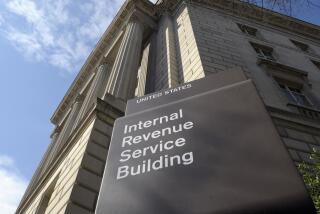Careful Year-End Tax Planning Can Save Investors a Bundle in April
The combination of stock options, active trading and investment losses spells both opportunity and risk for investors who hope to do a little last-minute tax planning this year. There are several steps you can take in these final days of 2000 to reduce the tax bite in April. But be careful.
Standard tax advice is to take capital losses, give to charity and troll for deductible expenses at this time of year. But if you exercised incentive stock options in 2000, that may be bum advice. That’s because you could be subject to the dreaded alternative minimum tax, which takes away the benefit of many itemized deductions. If you’re subject to the AMT, you’ll want to postpone deductible expenses.
For the record:
12:00 a.m. Dec. 17, 2000 For the Record
Los Angeles Times Tuesday December 12, 2000 Home Edition Business Part C Page 3 Financial Desk 2 inches; 49 words Type of Material: Correction
Tax Planning--Some words were inadvertently dropped in Sunday’s personal finance story, “Careful Year-End Tax Planning Can Save Investors a Bundle in April.” The paragraph should have read: You can offset capital gains with capital losses. Any excess losses above your capital gains can be used to offset up to $3,000 in ordinary income each year.
For the Record
Los Angeles Times Sunday December 17, 2000 Home Edition Business Part C Page 3 Financial Desk 2 inches; 50 words Type of Material: Correction
Tax Planning--Some words were inadvertently dropped in last Sunday’s Personal Finance story, “Careful Year-End Tax Planning Can Save Investors a Bundle in April.” The passage should have read: “You can offset capital gains with capital losses. Any excess losses above your capital gains can be used to offset up to $3,000 in ordinary income each year.”
However, if you exercised non-qualified stock options--or didn’t exercise stock options at all--you probably want to search mightily for deductions. If you’re an active trader or have large positions in taxable mutual funds, your tax obligation may be greater than you expected. Finding a few deductible expenses can reduce your taxable income for 2000 and cut the amount you’ll owe.
To simplify the year-end planning process, put yourself in one of two categories: a person who has incentive stock options, or one who doesn’t. You also fall into the “with” category if you paid a huge state income tax bill in 2000, perhaps because of recognizing a large capital gain. That, too, can trigger the AMT, so figure that the “have” category stands for those who have potential tax problems.
Planning for the “have nots”
If you don’t think you’ll fall into the AMT trap, your tax planning strategy is traditional. You want deductions, the more the merrier.
Before Dec. 31, you should:
* Look for capital losses that can be triggered by selling a money-losing stock. You can offset capital gains with capital losses. Any excess losses above your capital gains can be used to offset up to $3,000 in ordinary income each year.
Stay out of the stock for at least 31 days after the sale, and don’t buy any shares within 30 days before the sale, either. Otherwise you could trigger so-called wash sale rules and you can’t deduct the loss.
Sell “specific shares” if you want to generate the biggest capital loss from a stock you’ve accumulated. To do this, tell your broker to sell the shares you bought at the highest price. Keep records of your instructions in case you’re audited. (If you don’t specify, the IRS assumes that the first shares you sell are the first ones you bought.)
If you don’t know what you paid for your stock or precisely when you purchased it, ask your broker.
* Make charitable gifts with appreciated assets. If you own stock that’s worth more than you paid for it, consider making charitable donations in stock rather than cash. Because the charity is tax-exempt, it doesn’t have to pay tax on the gain when it sells the shares. And you get a tax deduction for the current market value of the stock.
One caveat: Make sure you’ve owned the shares for more than a year. Otherwise, you get to deduct only your cost in the stock, not today’s market price.
* Pay state income taxes and property taxes before year’s end. The second installment on your property tax bill may not be due until February, but if you pay it now, you get a tax deduction on your 2000 return. The same holds true for your state income taxes. If you’ve underpaid your 2000 state taxes, you’ve cost yourself a federal income tax deduction that might have come in handy in April.
* “Bunch” other deductions into one year to make better use of them, especially if you’re teetering on the verge of being able to itemize instead of taking the standard deduction.
Here’s how bunching works: One year, you take the standard deduction and postpone any expenses that qualify for tax write-offs, such as charitable contributions, miscellaneous itemized business expenses and, to whatever extent possible, state taxes and mortgage interest expenses. Then, increase or double those expenses in the following year to push yourself well above the itemized deduction threshold. Sagely flipping back and forth can save hundreds of dollars in income taxes.
* Make January’s mortgage payment in December. This gets you a little extra deductible interest expense this year. But naturally, you’ll lose the value of that deduction next year. (Or, “bunch” that payment into whichever year you’ll be itemizing.)
* Contribute to an IRA. Here’s something you can do any time before April 15, 2001, and still get a break on your 2000 taxes. If you can, make a deductible contribution to a traditional IRA, which can reduce your taxable income by up to $2,000 per person, or $4,000 per couple.
If you can’t deduct your contribution, consider making a contribution to a Roth IRA. You don’t get an up-front deduction for Roth contributions, but if you follow the rules, you’ll be able to pull both principal and profit from the account tax-free at retirement.
Tax planning for the “haves.”
The difference between incentive stock options and non-qualified stock options is how they are taxed. Non-qualified stock options--if you have these, look for your tax planning advice in the “have not” section--are taxable the day you exercise them. That’s the day you use the options to purchase your company’s stock at a discount from its current market price.
If you have incentive stock options, the paper profit is not immediately taxable. Your profit is taxed only at the time you sell the shares. (When you exercise an option, you’re buying the shares. You have a paper profit if your option price--and thus the cost of the shares--is less than the going market price. However, you don’t take home a real profit until you sell those shares for cash.) Then, if you hang on to the stock for at least a year after exercise and at least two years after the stock options were granted, any profit you realize will be taxed at favorable capital gains rates.
Beware: The paper profit on the day of exercise is a so-called AMT preference item. That means it goes into a complicated calculation to determine whether you owe alternative minimum tax. Being subject to the AMT means one simple thing: Your federal income tax bill rises.
How do you know whether you’re in AMT territory? Among the warning signs: You have exercised incentive stock options, you have substantial state income tax deductions, high medical deductions, high miscellaneous itemized deductions or an unusually large family--more than 10 dependents--or some combination of those.
But the only way to know for sure is to do a tax projection, where you pencil out your income, deductions and credits on a 1040 form and on the AMT work sheet. If the AMT calculation comes to a higher tax obligation than what you’d owe on the 1040, you owe AMT tax.
If you’re flirting with the AMT:
* Postpone paying state income taxes until January. That’s likely to shove these expenses into a year that you can get some mileage from them. But be careful not to postpone so much of your state tax obligation that you end up stuck with penalties or paying AMT in 2001.
* Push any miscellaneous itemized deductions, such as non-reimbursed business expenses, into next year, too.
* Consider delaying major charitable contributions until the new year. Charitable contributions are not so-called AMT preference items, but you may get more bang for your charitable buck if you make the contribution in a year when your marginal tax rate is higher.
* Exercise early. If you have incentive stock options but haven’t exercised them, consider doing so if your company’s stock price is relatively low--as long as you think the company will prosper in the long run.
Exercising while the price is low reduces your chance of running afoul of the AMT. But if you have substantial paper profits with incentive stock options, consider getting professional tax advice. When the AMT starts to threaten, good counsel could save you a bundle in tax.
*
Times staff writer Kathy M. Kristof, author of Investing 101 (Bloomberg, 2000), welcomes your comments and suggestions but regrets that she cannot respond individually to letters or phone calls. Write to Personal Finance, Business Section, Los Angeles Times, 202 W. 1st St., Los Angeles, 90012, or e-mail kathy.kristof@latimes.com. For past Personal Finance columns, visit The Times’ Web site at https://www.latimes .com/perfin.
(BEGIN TEXT OF INFOBOX / INFOGRAPHIC)
Tax Tools
Need some tax help? Here are a few Web sites that may offer the answers you need.
www.irs.gov: For help with tricky issues, there’s no better place than the Internal Revenue Service Web site. The catch: It’s massive, and finding what you need can be tough. You can call the IRS hotline ([800] 829-1040) for assistance.
www.turbotax.com: Provides advice, updates and an offer to file your tax return over the Web for $9.95. Also offers tip sheets on a variety of tax topics.
www.taxcut.com: This site offers tax tips and information, including what has changed for the 2000 filing season.
www.gainskeeper.com: This site keeps track of the cost of your stock, automatically accounting for mergers, spinoffs and splits. Useful for active traders. Offers a 30-day free trial.
Source: Los Angeles Times
More on Money
Previous Times stories, columns and special packages of interest to investors and savers are available on The Times’ Web site, www.latimes.com/business. A sampling:
* Quarterly Investment Report: The Times’ most recent quarterly investment review focused on how to sharpen your portfolio and your personal finances for the new market environment. At www.latimes.com/business/reports/3q2000
* Mutual Fund Capital Gains: Mutual funds are gearing up to make their annual capital gains payments to shareholders. A package of stories tells fund owners what they need to know. At www.latimes.com/capgains
* Stock Exchange: Review the weekly discussions between Times staffers Michael Hiltzik and James Peltz about the prospects for selected stocks. At www.latimes.com/stockex
* Hot and Cold Stocks: Daily updates on the stocks that have had the greatest momentum up--or down--in the last four weeks. At www.latimes.com/hotcold
* Fund Reports: See how your mutual fund stacks up or research new ones. At www.latimes.com/funds
* Money Make-Over: Learn from the experience others have had in handling money and see how professional financial planners advise individual Southland families with specific financial goals. At www.latimes.com/makeover
* Times Columnists: Catch up on recent columns you may have missed by Tom Petruno, James Flanigan, Liz Pulliam Weston, Kathy Kristof and others. At www.latimes.com/bizcols
Source: The Times
More to Read
Inside the business of entertainment
The Wide Shot brings you news, analysis and insights on everything from streaming wars to production — and what it all means for the future.
You may occasionally receive promotional content from the Los Angeles Times.










